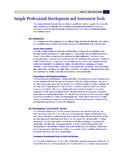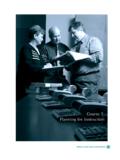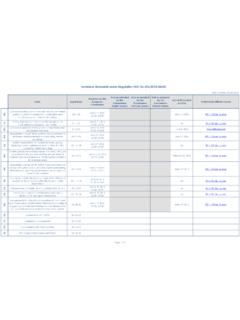Transcription of Skill Standards for Professional- Technical College ...
1 Skill Standards for professional - Technical College Instructors 2012 Update 1. 2. Copyright 2012 State of Washington through the Center of Excellence for Careers in Education. Unless otherwise provided, data which origi- nates from this agreement, shall be works for hire as defined by the Copyright Act of 1976, and shall be owned by the State of Washington. Data shall include, but not be limited to, reports, documents, pamphlets, advertisements, books, magazines, surveys, studies, computer programs, films, tapes, and/. or sound reproductions. Ownership includes the right to copyright, patent, register, and the ability to transfer these rights. For More Information Contact: Erik Tinglestad, Executive Director, Center of Excellence for Careers in Education, Green River Community College . (253) 833-9111 ext. 4359, Project Funding Financial support for this project was provided by the Center of Excellence for Careers in Education through funding from the Workforce Education Council.
2 Permission to Cite General permission is granted for educators to photocopy and quote limited material from this document for noncommercial instructional or scholarly use. Permission must be sought from the Center of Excellence for Careers in Education to charge for photocopies, to quote material in advertising, or to reprint substantial portions of the document in other publications. Credit should always be given to the source of the photocopies or quotes by citing a complete reference. Copies of Document Additional copies of the document can be downloaded at no cost: Document Credits Project Director, Alan Hardcastle , Washington State University (WSU) Energy 3. Program, (360) 956-2167, Research, facilitation and Technical writing by Terryll Bailey, The Allison Group (206) 525-7175, Acknowledgements This document is the result of the collaborative efforts of industry, labor, education, and government successfully working together through the Center of Excellence for Careers in Education.
3 A special thanks to all who contributed, and especially to the faculty members who participated in the focus groups. Their countless hours of work to help produce the Skill Standards are greatly appreciated. Project Development and Coordination: Erik Tinglestad, Green River Community College Alan Hardcastle, WSU Energy Program Terryll Bailey, The Allison Group Sally Zeiger Hanson and Gerry Rasmussen, WSU Energy Program Focus Group Participants The focus group participants consisted of nine College faculty members from a variety of fields, representing a cross section of Washington's 34 two-year colleges. They met over a two-day period at Kent Station to review and update the critical work functions and key activities performed by professional Technical College Instructors. They then identified the performance indicators, Technical knowledge, skills and abilities, and employability skills required to succeed in this field.
4 Their insights were an invaluable contribution and formed the foundation of this work. Participants included: Christine Beaudry Radiologic Science Yakima Valley Community College Greg Brazell Early Childhood Education Pierce College , Fort Steilacoom Rod McDonald Welding Grays Harbor College Jeff Ward Business Highline Community College Jim Howe Computer Science Lake Washington Institute of Technology Margaret Anderson Physical Therapist Assistant Whatcom Community College Mark Franklin Diesel and Heavy Equipment Spokane Community College Penny Woodruff Nursing Grays Harbor College (Original Skill Standard Participant). Karen Strickland (observing) Human Services South Seattle Community College American Federation of Teachers (AFT) WA. 4. Table of Contents National 7. What Are Skill Standards ? .. 7. The Benefits and Uses of Skill 8. Pyramid of 9. Background on the 2012 Skill Standards 10.
5 Skill Standards Update 10. Project Steering 11. Focus 11. 12. Definitions .. 12. Technical skills , Knowledge, Abilities and 13. SCANS Employability 13. Skill Standards for Professional- Technical College 14. Critical Work Functions: A. Manage Learning 16. B. Develop Outcomes, Assessments, and 23. C. Develop and Review 28. D. Provide Student 35. E. Provide Support and Guidance to 40. 5. F. Perform Administrative and Program Management 45. G. Create and Maintain a professional 52. H. Promote the Program and Recruit 57. SCANS Survey 61. 6. National Context The National Skill Standards Board (NSSB) was established by Congress in 1994. to encourage the creation and adoption of a national system of voluntary Skill Standards that would enhance the ability of the to compete effectively in a global economy. By the time the NSSB sunset in 2003, several national voluntary Skill Standards projects were developed by various industries in full partnership with education, labor and community-based organizations.
6 The intent was to have voluntary Skill Standards that are flexible, portable, and continuously updated and improved. Washington State was an early leader in the development and use of industry- defined Skill Standards , contributing to the development of a national model and creating Skill Standards to align the needs of industry with the provision of workforce education and training. What Are Skill Standards ? Skill Standards are performance specifications that identify the knowledge, skills and abilities an individual needs to succeed in the workplace. They are critical to improving workforce skills , raising living Standards and improving the competi- tiveness of the economy. To be effective, Skill Standards must reflect the con- sensus of industry professionals. Skill Standards provide measurable benchmarks 7. of Skill and performance achievement. They answer two critical questions: What do workers need to know and be able to do to succeed in today's workplace?
7 And how do we know when workers are performing well? Without this funda- mental information, employers do not know whom to hire or where to focus their limited training dollars; employees and new entrants to the workforce do not know what they need to do to improve their performance; and educators do not know how to prepare students for the challenge of the workplace. Why Are Skill Standards Important? In today's workplaces, the only constant is change. Jobs that once were relatively simple now require high-performance work processes and enhanced skills . Because Skill Standards reflect changing workplace realities, they are a tool that can be used by applicants and employees to access greater career opportunities. National recognition of Skill Standards in career fields provides a common basis for certifying achievement against those Standards , thereby allowing for the portability of skills across geographic areas, companies and careers.
8 Updating skills and knowledge is now a lifelong endeavor, causing many employers and employees to spend more effort, time and money on education and training. Skill Standards provide benchmarks for making education and training decisions, shaping curricula and directing funds toward highest value education and training investments. The Benefits and Uses of Skill Standards Skill Standards benefit all the stake-holders business, labor, educators, govern- ment, and the community. The success of a Skill Standards development project and its usefulness to the community is dependent on the full participation and commitment of all stakeholders. These benefits can be used as a benchmark for evaluating the effectiveness of collaborative efforts. Curriculum Development Identify necessary competencies based on the Skill Standards information and assessments. Develop program outcomes for specific academic and training programs, including Tech Prep, two-year, and apprenticeship programs.
9 Perform gap analysis to determine changes or additions to be made to curriculum. Revise existing curriculum to better meet the current and future needs of the industry. Develop new curriculum and establish new programs based on these competencies. Articulation 8 Develop models to support the articulation of program outcomes and competencies between academic and training systems. Establish articulation agreements between existing programs to ensure portability of skills . Connect competencies and Certificates of Competence with benchmark documentation to build national portability systems. A Continuous Updating Process A continuous updating process is necessary: all partners must revise and verify Skill Standards on a regular basis. For national economic development success, curriculum and current training methods must be updated to meet workplace Standards . Individual workers must have access to clearly stated competency goals and direct access to Skill development assistance.
10 With cooperative effort on local and national levels, we can begin to resolve the workforce Skill shortages that face us today Pyramid of Competencies The Pyramid of Competencies (see Figure 1) is a depiction of Skill Standards in three broad Skill categories. Tier I. Tier I represents the broadest level of competencies, and is the set of employ- ability (SCANS) skills , knowledge, abilities and personal qualities required of all workers to be successful in today's workplace. These are the universal skills that are needed to apply Technical knowledge and tools effectively. Tier II. Tier II represents Technical skills , knowledge and abilities common to a cluster of jobs within a cluster across all industries or industry sectors. Tier III. Tier III represents industry-specific Technical skills , knowledge and abilities that are unique to individual jobs or clusters and are the most prone to rapid change.










